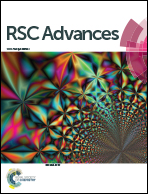Heavy metal pollution and human health risk assessment at mercury smelting sites in Wanshan district of Guizhou Province, China†
Abstract
The Wanshan district of Guizhou Province has a long history of mercury mining and smelting. Previous studies have been carried out on heavy metal (HM) pollution in the soil around Wanshan (such as in urban and farmland areas), but these studies have not been conducted at mercury smelting sites. In this study, the distribution characteristics of As, Be, Cd, Cr, Cu, Hg, Ni, Sb, Pb and Zn and their sources in the shallow stratum (<10 m) of the mercury smelting site in the Wanshan district were analyzed. Human health risks were evaluated using deterministic risk assessment (DRA) and probabilistic risk assessment (PRA) models. The contribution rates of different HM sources to human health risks were also calculated. The maximum HM concentration in mercury smelting site soil occured in the shallow soil (0–1 m), and the concentration sequences were as follows: 358.51 mg kg−1 (Hg) > 248.6 mg kg−1 (Zn) > 67.42 mg kg−1 (As) > 59.04 mg kg−1 (Ni) > 57.56 mg kg−1 (Pb) > 49.59 mg kg−1 (Cr) > 46.65 mg kg−1 (Sb) > 15.65 mg kg−1 (Cu) > 2.02 mg kg−1 (Be) > 0.78 mg kg−1 (Cd). The variable coefficients (CVs) were 1.64 (As), 0.67 (Be), 3.15 (Cd), 1.89 (Cr), 0.95 (Cu), 3.08 (Hg), 0.79 (Ni), 1.41 (Sb), 0.68 (Pb) and 1.13 (Zn), respectively. The HM concentrations in deep soils (9 m) still exceed the local background values, suggesting that heavy metals in shallow soil have migrated downward in the site. Three pollution sources identified with the shallow soil (0–1 m) HMs using the positive matrix factorization (PMF) model, were mercury smelting and coal combustion mixed sources (As, Hg and Zn), parent material sources (Ni, Cu, Cr, Cd and Sb) and wastewater discharge sources (Cu and Pb), respectively. DRA indicated that oral ingestion was the main pathway affecting the carcinogenic risk (CR) and hazard quotient (HQ) of heavy metals. The total-CR of twenty-five sampling points is between 1.219 × 10−6 and 3.446 × 10−4, and the total-HQ is between 0.37 and 43.56. PRA results indicated that DRA will underestimate the health risk of all populations in Guizhou Province, especially female, and BWa is the most influential variable for the PRA results. Smelting and coal combustion mixed sources contributed the most CR (99.29%) and with an HQ of 89.38% were the major sources of pollution affecting human health.



 Please wait while we load your content...
Please wait while we load your content...